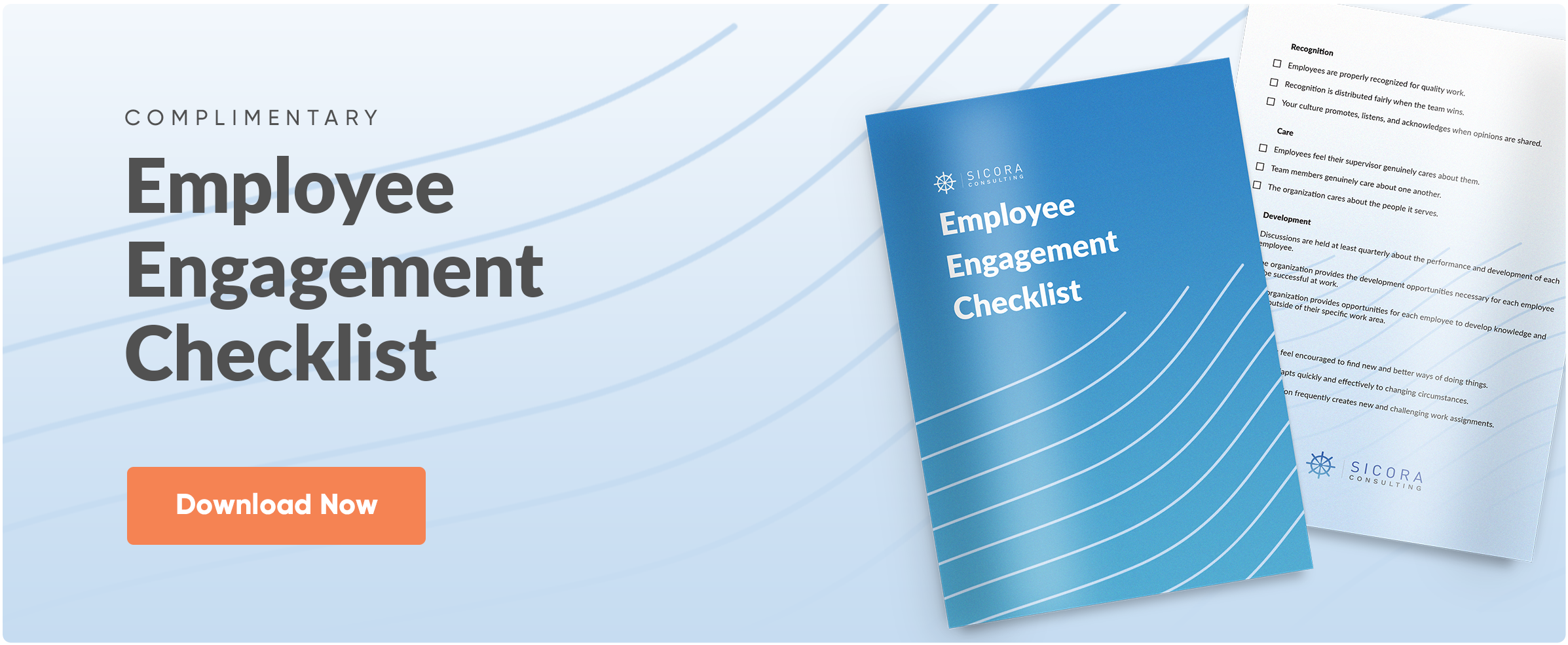Building a culture rich in employee engagement can be a significant difference-maker for your organization – but doing so is almost always easier said than done. On average, only 24% of employees are actively engaged, leaving the rest feeling entirely disengaged or somewhere in between. This discrepancy has a negative impact across your culture, productivity, and bottom line.
To combat this, you need a sustainable process that instills employee engagement deep within the fiber of your organization.
But first, let’s take a step back.
What is employee engagement?
There are many different components that make up employee engagement – and many different ways to go about cultivating it – but ultimately, it centers on creating a culture and environment that allow employees to:
- Deliver their best work on a daily basis
- Contribute to the short- and long-term goals of the organization (while knowing and caring that they’re doing so)
- Experience fulfillment in their work on a daily basis
- Fully trust and care for one another on both a personal and professional level
At its core, employee engagement provides your workforce with a sense of belonging and motivation to contribute to the greater success of the group.
Why should you want your employees to feel engaged?
You may be thinking, “That all sounds flowery and wonderful, but what will employee engagement actually achieve for my organization?” Here are just a few of the culture-shifting benefits it can provide:
- Increased productivity and loyalty to the team
- Increased motivation to produce better and more innovative work
- An activation of your employees’ passions
- Increased commitment to the success of the organization
- Improved customer delight and client loyalty
- A strengthened emotional connection between team members, leadership, and the organization
- Improved organizational processes
- An overall positive impact on organizational results
Not only does employee engagement have far-reaching benefits, but disengaged employees can also pose a threat to your organization and its future. When employees are less happy, both the quantity and quality of the work take a hit.
Poor morale is infectious, and can quickly spread throughout your organization if not properly addressed. Actively disengaged employees are more likely to speak negatively about your brand, either while they’re still a part of it or after they’ve moved on. A lack of engagement is likely to foster a toxic work environment and a loss of trust across the organization.
And it’s not only morale or reputation that are at stake. The lack of productivity associated with disengaged employees can also serve as a detriment to your revenue in the long-term.
You get the picture. Employee engagement matters. So how do we get there?
Introducing the 8 Factors of Engagement
The 8 Factors of Engagement is a science-based model that promotes trust, shared purpose, and improved performance among your workforce. Let’s dive into each of the eight factors to see how each one can contribute to fostering an employee-led culture of continuous engagement within your organization.
Purpose
Purpose is the most critical factor of engagement. It’s important employees’ work is tied closely to their passions and that everyone’s individual purposes are aligned with those of the team. Employees should understand that they are more capable collectively than alone. This shared belief and motivation is extremely infectious and can cultivate increased engagement at every level.
When accompanied by Trust, Purpose has also been proven to enable resiliency in times of great change or turmoil (as all organizations have been experiencing in 2020). This is what makes establishing a clear purpose and ensuring staff alignment so critical.
Check in regularly with your team members on this, because it can be easy for a sense of purpose to slip away even if it seems well established for a period of time.
Questions to consider:
- Are my employees doing work they’re passionate about every day?
- Do they understand how their work aligns with the goals of the organization?
- Are they given a sense of purpose in accomplishing the mission of the organization?
Accountability
If employees don’t have a clear understanding of what’s expected, it’s easy to fall short. A surprising number of workers rarely receive feedback from supervisors on their performance, and very few of those that do find the feedback to be useful in moving forward.
You need to chart a clear course for success. On both an overarching role level and a project-to-project level, goals and expectations should be clearly defined to set the table for progress and eventual achievement.
Accountability can take the form of:
- SMART goals
- Documented processes and expectations
- Regular check-ins
Questions to consider:
- Have clear expectations been set for employees to deliver great work?
- Is each staff member held accountable for the quality of their work?
- Are high standards for quality clearly set and maintained at every level of the organization?
Resources
For employees to do their jobs to the best of their ability, they need access to certain tools. Just as you wouldn’t send a sailor to the harbor without a map and compass, you shouldn’t send your employees to work without everything they need to get the job done – and get it done right.
Whether this includes specific software, training and onboarding information, or simply candid access to the right people, no one should be expected to produce their highest-quality work if they’re not set up to do so.
Questions to consider:
- Does every employee have the resources they need to produce great work?
- Does every employee have access to the people needed to effectively do their job?
- Does every employee have access to the information needed to effectively do their job?

Trust
Trust is essential to successful business practices – and to all levels of your organization. There needs to be trust among team members to effectively collaborate and rely on one another. Team members also need to be able to trust leadership – trust that they’re providing transparent information and are intent on following through with what they say.
Trust permeates across several other engagement factors, as well – trust in employees to follow through (Accountability), trust that leadership has your back (Recognition and Care), trust your organization wants you to succeed (Development), and so on.
Questions to consider:
- Do employees have people at work they can genuinely trust?
- Do team members trust one another to complete assigned tasks?
- Is leadership consistent in what they say and what they do?
Recognition
When employees do good work and contribute to the success of the organization, they need to be recognized for that in the right way – and those that aren’t are more likely to leave.
Many people think employee recognition is best achieved through promotions and raises, but it is really about much more than that. True recognition is about proper acknowledgement and ensuring employees know their thoughts, ideas, efforts, and impact are all felt and sincerely appreciated. It also validates them as a person – not just a worker.
Each employee has different ways in which they like to be acknowledged, and this will impact whether or not they feel truly recognized. Understand each of your team members individually and take time to recognize their performance through either public or private shoutouts (teamwide email or one-on-one praise, for example). Recognition done right is free and easy and can make a huge difference for your employee engagement and retention.
Questions to consider:
- Are employees being properly recognized for quality work?
- Is recognition fairly distributed when the team wins?
- Does your culture promote, listen, and acknowledge when opinions are shared?
Care
Employees need to be made to feel they are more than just a number. It’s easy for employees today to feel dispensable and not cared for as human beings – and this can be extremely detrimental to employee engagement and performance.
Whether this means lending an ear, showing appreciation, or establishing a cadence for social team events, taking steps to show you are present, open, and trusting can help unify your team and yield outstanding results.
Care combined with Purpose creates a superfactor known as Belonging. To truly care for one another while sharing a common purpose cultivates one of the strongest bonds an organization can experience.
Questions to consider:
- Do supervisors genuinely care about employees?
- Do team members genuinely care about one another?
- Does the organization care about the people it serves? (i.e. customers, clients, and community)

Development
Investing in the future of your employees is a necessary aspect in fostering better engagement. This doesn’t just have to do with promotions and raises, but also opportunities for employees to identify their goals and then pursue them.
Consider that 30% of employees find career opportunities to be very important, but only 30% are happy with the availability of those opportunities. If done properly, this investment can return tenfold as employees begin learning new skills, delivering better work, and feeling more invested in their own futures and that of the team.
Questions to consider:
- Are discussions being held at least quarterly regarding the performance and development of each employee?
- Does the organization provide the development opportunities necessary for each employee to achieve their goals?
- Does the organization provide opportunities for each employee to develop knowledge and skills outside of their specific work area?
Agility
Engaged employees don’t feel stagnant or locked into ways of doing things. They are agile, encouraged to pursue new ways of thinking, and willing to adapt and rise to challenges that present themselves. An engaged workforce doesn’t run from heavy winds or crashing waves – it runs toward them, together with a plan to overcome and reach the shore.
Questions to consider:
- Do employees feel encouraged to find new and better ways of doing things?
- Does the team adapt quickly and effectively to changing circumstances?
- Does the organization frequently create new and challenging work assignments?
Experience the impact of true employee engagement with Sicora Consulting
Sicora Consulting has helped organizations of all sizes and in all sectors elevate their employee engagement to achieve improved morale, productivity, and results. Through our 8 Factors of Engagement program, we leverage direct input from you and your team to deliver actionable solutions for sustainable change.
Organizations that utilize the 8 Factors of Engagement experience an increase of 15% in actively engaged employees within nine months or less.
Contact us today to sail into 2021 with a greater resolve of purpose and a foundation of trust.

